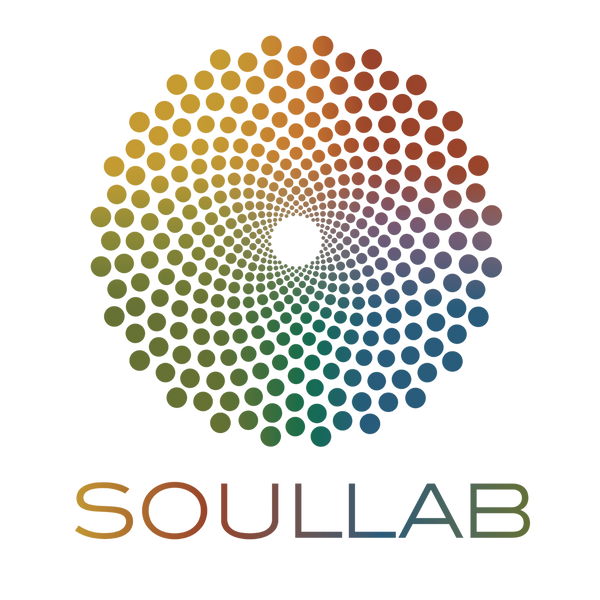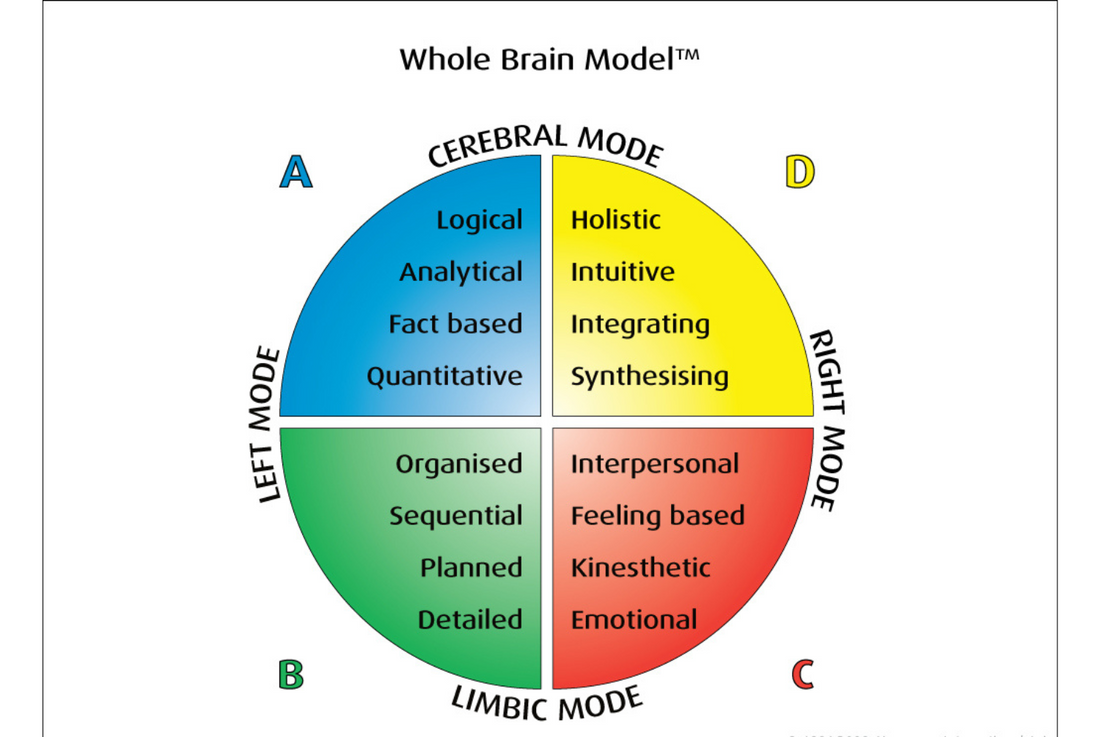Uniting the Four Brain Model with the Elements:
A Path to Personal Development and Higher Consciousness- or “the anarchists blueprint to radical independence and creative interdependence”
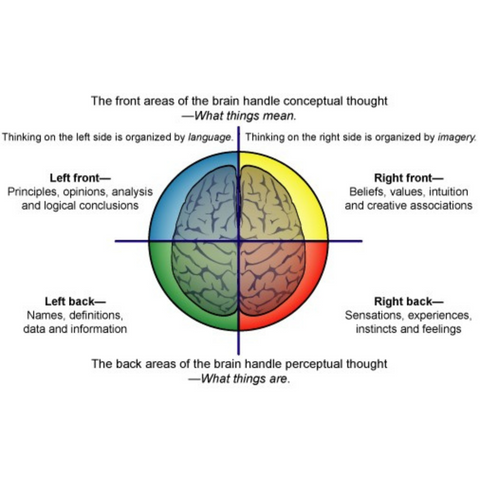
Introduction
In our quest for personal development, we often search for ways to enhance our understanding of ourselves and the world around us. The journey towards self-discovery and higher consciousness can be enriched by combining various models of understanding. In this blog post, we'll explore a powerful synthesis of the four brain model and the four elements, which can help us navigate reality, enhance our self-awareness, and unleash our creativity. In this study, you’ll see that there is a correlation between the four elements of consciousness which has been the focal point of most, if not all, major cultures not only reflects our connection with nature but also reflects the nature of our brain’s architecture. The correlation reflects both the neurological influence on our consciousness as well as the elemental dance between the mystical and the mundane, the sacred and the profane, and the transcendent and the everyday.
Uniting the Four Brain Model with the Four Elements of the Spiralogic Model
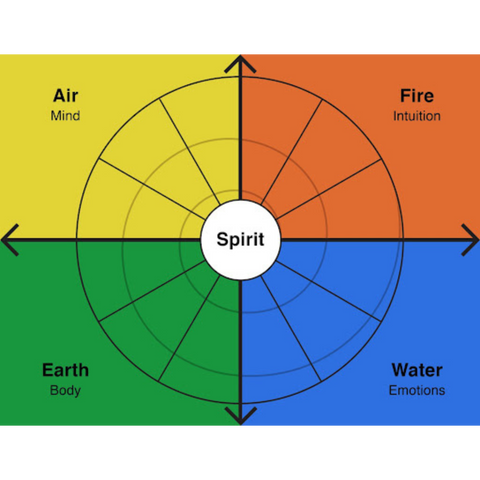
creates a powerful framework for personal development, shamanic consciousness, and higher consciousness. This integration offers a way to align our inner and outer worlds for maximum growth, enabling us to understand our cognitive and emotional experiences more holistically. The Four Brain Model and the Spiralogic model are both based on a phenomenological approach to process and brain function, i.e., consciousness.
- The left prefrontal cortex, linked with logical reasoning, decision making, and planning, corresponds with the Air element.
- The right prefrontal cortex, responsible for creativity, intuition, and innovation, aligns with the Fire element.
- The right hemisphere, responsible for processing emotions and understanding the bigger picture, resonates with the Water element.
- The left hemisphere, associated with sensory perception, organization, and practical problem-solving, aligns with the Earth element.
- By embracing these elements, we can develop our abilities, including communication, creativity, emotional intelligence, and practical problem-solving.
The Four Brain Model
Our brain is an incredibly complex organ with various regions responsible for different functions. For the purpose of this discussion, we'll focus on four primary areas:
- Left Prefrontal Cortex Functioning
- Right Prefrontal Cortex Functioning
- Right Hemispheric Functioning
- Left Hemispheric Functioning
The Four Elements- Spiralogic Model
In many spiritual and philosophical traditions, the universe is divided into four elements that represent different aspects of reality. These elements are:
- Air: Intellectual, relational, communication, rational, reasoning, systems thinking.(LPFC)
- Fire: Intuitive, creative, visionary, projective, innovative, energetic, spiritual.(RPFC)
- Water: Emotional, feelings, inner meaning, depth, inner truth, psyche, subconscious. (RH).
- Earth: Sensible, sensory-oriented, organized, process-oriented, systems design, creative, grounded, rooted, resourceful. (LH).
Uniting the Four Brain Model with the Four Elements of the Spiralogic Model
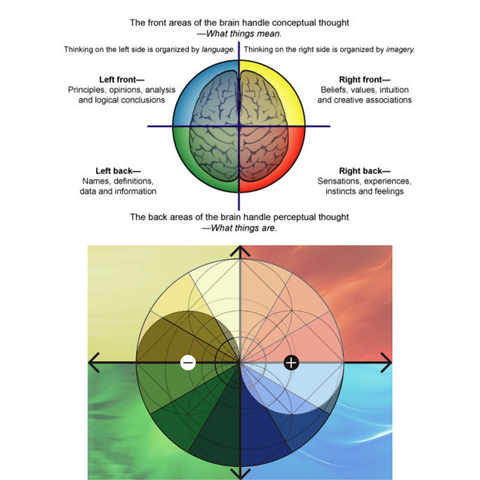
By uniting the four brain model with the four elements, we can create a powerful framework for personal development, shamanic consciousness, and higher consciousness. This integration helps us understand our cognitive and emotional experiences more holistically and offers a way to align our inner and outer worlds for maximum growth.
The left prefrontal cortex, associated with logical reasoning, decision making, and planning, corresponds with the Air element. By honing our Air-related skills, we can develop our ability to communicate effectively, form meaningful relationships, and think systemically. Embracing the Air element means cultivating a sharp, analytical mind that can identify patterns, evaluate situations, and plan for the future.
The right prefrontal cortex, linked to creativity, intuition, and innovation, aligns with the Fire element. By tapping into our Fire-related abilities, we can ignite our inner visionary, harness our spiritual energy, and bring our most creative ideas to life. Embracing the Fire element means stepping into our personal power, taking risks, and exploring the realm of "what if."
The right hemisphere, responsible for processing emotions and understanding the bigger picture, resonates with the Water element. By embracing our Water-related qualities, we can delve into our emotional depths, uncover our inner truths, and foster personal transformation.
Embracing the Water element means learning to navigate our subconscious mind, develop emotional intelligence, and understand the underlying motivations behind our actions and choices.
The left hemisphere, associated with sensory perception, organization, and practical problem-solving, aligns with the Earth element. By developing our Earth-related skills, we can create a solid foundation for our lives, improve our ability to manage resources, and design effective systems for achieving our goals. Embracing the Earth element means staying grounded, connecting with our senses, and maintaining a strong connection to the physical world.
Spiraling into Our Center of Awareness
The hero’s journey also has a quadrantal (four-sided nature) aspect to it that also correlates with the Elemental Model- as so many do.
As we integrate the four brain model with the four elements, we can create a powerful spiral of self-awareness and personal growth. By understanding the interconnected nature of our cognitive and emotional processes, we can develop a more balanced, holistic approach to personal development and higher consciousness.
So many powerful models have four elements and twelve phases of process- from the 12 step program to the Monomyth. This structure gets at the heart of the elements of human consciousness- perception and engagement- all happens through the elements.
To engage with this spiral of growth, consider the following steps:
- Reflect: Take time to explore your thoughts, emotions, and experiences in relation to the four brain model and the four elements. Identify areas where you feel strong and areas where you may need further development.
- Cultivate: Focus on developing the skills and qualities associated with each brain region and element. For example, practice mindfulness meditation to improve left prefrontal cortex functioning, or engage in creative activities to strengthen right prefrontal cortex functioning.
- Balance: Ensure that you are giving equal attention to all four brain regions and elements in your personal development journey. Strive for balance between logic and intuition, practicality and creativity, and emotional depth and intellectual clarity.
- Integrate: Recognize the interconnected nature of your cognitive and emotional processes and seek to create harmony between the four brain regions and elements. This can be achieved through activities such as journaling, art therapy, or engaging in holistic practices like yoga or tai chi.
- Expand: As you become more attuned to the four brain model and the four elements, expand your awareness to encompass not only your personal growth but also your impact on the world around you. Consider how you can use your newfound understanding to contribute positively to your community, environment, and the collective consciousness.
Conclusion
Uniting the four brain model with the four elements offers a unique and transformative approach to personal development, shamanic consciousness, and higher consciousness. By understanding and embracing the qualities associated with each brain region and element, we can create a dynamic and balanced approach to self-growth and self-awareness. This integration helps us spiral into our center of awareness, fostering a deeper connection with ourselves and the world around us, and empowering us to create a more fulfilling, purpose-driven life. This is a journey of a lifetime and we are here to help you experience every element of your life to its fullest.
Understanding the Four Brain Model and the Four Elements of Consciousness is like having a treasure map to unlock the potential of your mind. Just like how different parts of a ship need to work together to sail smoothly through the sea, different parts of your brain work together to create your consciousness.
The left prefrontal cortex, like the navigator on a ship, helps you chart your course through analytical thinking and logic. Meanwhile, the right prefrontal cortex, like the ship's artist, adds a touch of creativity and imagination to keep things interesting.
The right hemisphere, like the ship's emotional captain, uses empathy and intuition to guide you through the ups and downs of life's waves. Finally, the left hemisphere, like the ship's pragmatic engineer, keeps things running smoothly through practicality and routine.
Just like a ship needs all its parts to function effectively, our brains need all four elements of consciousness to reach our full potential. By understanding the unique strengths of each part of our brain and consciousness, we can harness their power to live a more satisfying life.
So, next time you're feeling lost at sea, remember that your brain is your trusty ship, and with the Four Brain Model and Four Elements of Consciousness as your guide, you'll be sailing towards success in no time.

